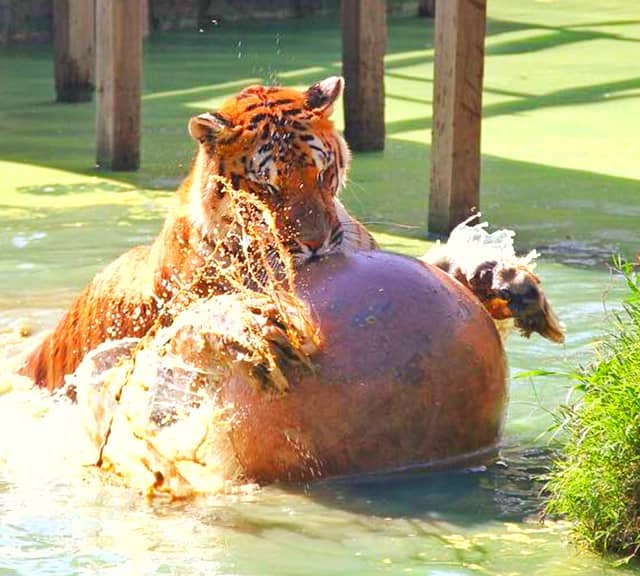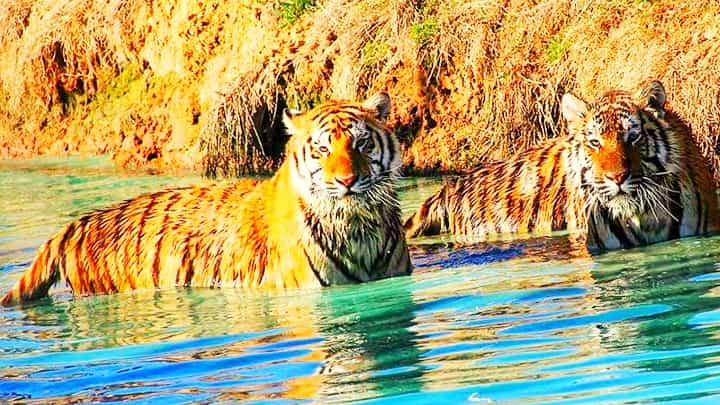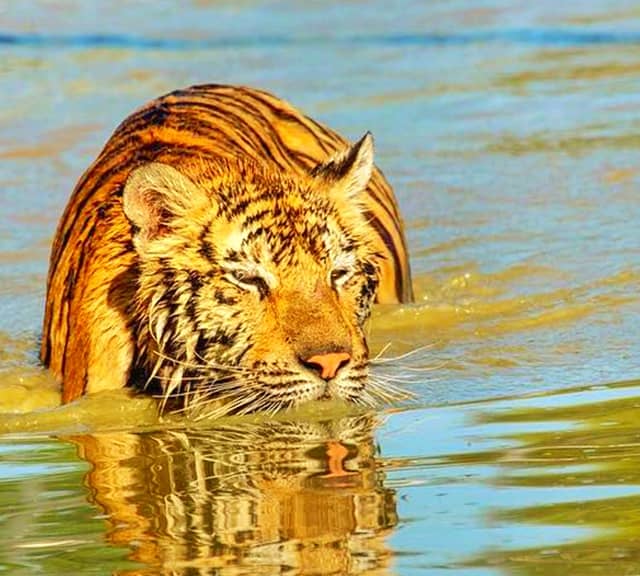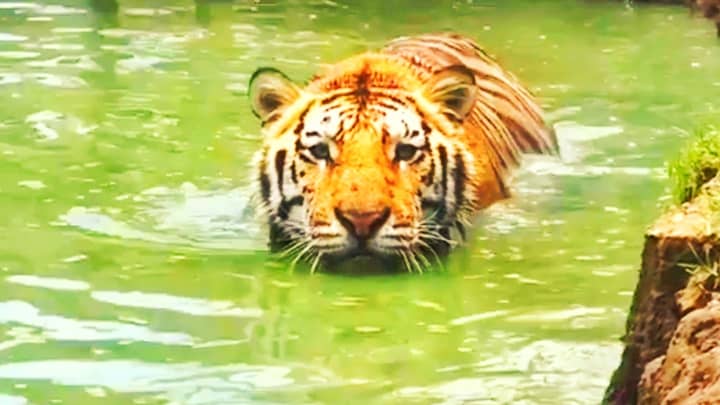Tigers Love Swimming
Tigers not only love to swim but they are also considered as one of the most skillful swimmers within the big cat family. Even though all the big cats are capable of swimming in water but the tigers are on another level when it comes to the swimming. In fact; the tigers are born swimmers, as they have a natural desire and instinct to go for the water right from the very young age.
The tigers love to swim and they are considered as the expert swimmers. Amongst all the big cats, the tigers are considered as the most skillful and successful swimmers.
Onwards; when they grow up, they utilize their swimming desire to their own advantage and that too in a great numbers of ways i.e., hunting and seeking new territories etc. According to the experts, if there is any big cat that knows how to swim and has a skill to do it in the best way, it should only be a tiger within the big cat family. Let's explore all such ways which a tiger utilizes for its own advantage via swimming within its own habitat!

The biggest advantage which the tigers utilize through swimming includes the hunting. On land they are already considered as the stealth hunters because of their camouflaged fur but in the waters, they are an equally dangerous predator. It doesn't matter whether the prey is bigger or smaller, a tiger will easily hunt it down even in the water. On the other hand; for most of the big cats, the hunt is almost a failure as soon as the prey takes the refuge in the water.
Swimming also makes them the biggest hunters as well. It is very common for a tiger to hunt a prey that takes refuge even within the water. Other big cats ignore the prey, if it goes to the water.
However; for the tigers the prey in water means that the target has been further locked down for the final blow. Therefore; no animal is safe from tigers whether on land or in water. Lastly; tigers are even known to attack the fishermen on the boats as huge numbers of such cases have been recorded within India and Bangladesh.
Tigers are so much dangerous and threatening in the water that they are known to attack the fishermen on the boats.

Another big advantage which the tigers utilize through swimming is in cooling down their body during the hot summers. Their lack of hesitation for water and love for swimming allow them to stay within water at any time whenever they desire. Tigers also sit within the ponds or small water reservoirs for almost the whole day. They also take a dip within the big rivers for the purpose of cooling down their body temperatures. Staying within the water also helps them to get rid of all kind of annoyance of the flies and bugs as well.
The love for swimming also allows the tigers to cool down during the hot summers. Tigers often stay in water ponds while resting. They even plunge into deeper water to cool down as well.
Most of the zoos and animal sanctuaries which have tigers always create a pool because they know the tigers' passion for swim and staying (sitting) in the water. Other big cats such as the lions and the leopards don't cool down this way. They usually sit under the shade of the trees to cool down their body temperatures.

Tigers are also one of the stealthiest swimmers in water. They remain unnoticed in water for the two big reasons. First; only the small portion of their body (head) is exposed outside the water while the rest of the body stays hidden when the swim. The prey doesn't think, it it's a tiger or any other predator. Secondly; the tigers are such an expert swimmers that they can swim without making much of the splashing noises.
Being excellent swimmers also make the tigers, the stealthiest hunters within waters. They quietly swim within the water and only a small portion of their head is visible which gives them the stealth advantage.
Therefore; they can quietly approach near the prey without making much of the noise. These two reasons really make the tigers as one of the dangerous stealth hunting big cats on the land and in the water. Another very big reason for the tigers to be stealthiest within the water is their ability to swim under water as well. This has been witnessed many times at a lot of swimming pools (clear water) and there is also the huge possibility that wild tigers would also have opted this tactic for hunting as well.

Tigers have a huge stamina for swimming the long distances. Tigers have very strong muscles which help them to swim such long distances. The depths and the lengths of the water have never been the hindrance for the tigers to swim these great distances. No other big cat has been witnessed to cover such a great distance in the water as the tiger. They can swim in all kind of waters; whether it is the canal or the big strong rivers.
Tigers have a great stamina for swimming which makes them capable of covering huge distances. They are known to cross rivers as wide as 30 to 35 kilometers of width.
The tigers are even known to have crossed one of India's major rivers, the Brahmaputra which goes as wide as 30 to 35 kilometers during the monsoon seasons. They can keep on swimming inside the rivers and canals for many hours and even many kilometers for the search of a prey. They are even known to successfully chase the fishermen for great distances as well. Therefore; all of these characteristics do indicate that the depth and the length of the river waters are no hindrance for the tigers to swim.

Swimming also helps the tigers to explore the new territories as well. If the water is separating one land from another, this may not be the hurdle for a tiger to cease its quest. A tiger will swim to reach the other part of the land for the exploration of the new territory or simply for the hunting. This behavior is very common within juvenile or the young tigers which are in the process of establishing their new territories.
Swimming also allows the tigers to explore the new territories either for the purpose of hunting or living. They are not shy of water, if it is separating one land from another.
Swimming also helps the tigers to explore the new territories as well. If the water is separating one land from another, this may not be the hurdle for a tiger to cease its quest. A tiger will swim to reach the other part of the land for the exploration of the new territory or simply for the hunting. This behavior is very common within juvenile or the young tigers which are in the process of establishing their new territories.

Researchers are yet to measure the average swimming speed of the tigers. However; it can be safely assumed that their swimming speed will be faster than the human swimmers. Nat Geo Wild has quoted the speed of the tiger while swimming to be twice and even thrice faster than the swimming speed of an average Olympic swimmer.
Tigers swim really fast and they can easily out swim a human while swimming. A tiger is twice and even thrice faster swimmer as compared to an Olympic swimmer.
Because of their powerful muscles, the tigers might well be the fastest swimmers amongst all the big cats as well. Therefore; if a tiger is after a human within the water, there are greater chances that a tiger will out swim a human. This is the key reason that the tigers of the Sundarban have a fearsome reputation of killing dozens of fishermen each year because they chase them down even on the boats.

Amongst all the big cats, only two of them i.e., the tigers and the jaguars have successfully evolved themselves as the formidable swimmers. Tigers in particular are very high profiled swimmers while Jaguars are nothing short of any introduction at all. Both the tigers and the jaguars are expert hunters within deep and shallow waters.
Tigers and the jaguars are the only two big cats that have successfully evolved themselves as the expert swimmers. Both big cats are considered as the formidable predators while swimming in the water.
Jaguars are even known to hunt the caimans within water and they have the strongest bite force of all the big cats. Furthermore; both the tigers and the jaguars live within the habitat that promises prey within waters and on land. Among lions; only the marsh pride is considered as the expert swimmers but they are still not as efficient swimmers as the tigers and the jaguars.

Lastly; when do the tiger start swimming in their lives? In the wild; the swimming lessons for the tiger cubs start very early in their lives. As little as 10 weeks old tiger cubs are known to have swum in the wild. At this stage of their lives, they just overcome the fear of water and maintain a firm expertise of swimming to become the apex predator of water.
In the wild, as little as 10 weeks old tiger cubs are known to swim with their mothers. They learn swimming very young and when they grow up they become apex predator of water as well.
However; when the danger lurks, the cubs less than 10 weeks old have also been witnessed crossing the water canals. On the other hand; their hunting adventures for the swimming only starts at the adult age.

Liger Articles
Why Li-Ligers are Born so Late?
Liger Stripes vs. Tiger Stripes
Ligers, Ti-Ligers & Ti3-Ligers
Ligers & Big Cats Conservation
Lions have Spotted Marks on their Fur
White Ligers have Light Brown Fur
1st, 2nd & 3rd Generations of Hybrid Big Cats
Ligers, Li-Ligers & Li3-Ligers
Non-Sterile Ligers - The Truth
Ligers have more Stripes than Tigers
Tiger Lookalike Ligers - Types
Ligers at Zoological Wildlife Foundation
Ligers at Chang Puak Camp - Hat Yai, Thailand
Ligers at Octagon Wildlife Sanctuary
Hybrid Big Cats of the 21st Century
Ligers in Guinness Book of World Records
Ligers & Deformity - Myth or Reality?
Taman Safari Zoo Liger in Indonesia
Lujan Zoo Ligers at Buenos Aires, Argentina
Myrtle Beach Safari - The Liger Hub
Tiliger = A Tiger & Ligress Offspring
Tigon = A Hybrid of Tiger & Lioness
Liliger - An Offspring of Lion & Liger
Liger - Informationen, Fotos, Videos und Forschung Artikeln
Liikeri - Tietoa, valokuvia, videoita ja Tutkimus Artikkelit
Liger - Informasjon, bilder, fakta, forskning, Profiler og Magazine artikler
Ligre - Informations, Vidéos, Photos et articles de recherche
LIGER - informacije, slike, videi in raziskovalni clanki
Liger - Ligern - Information, Upplysning, Bilder, Filmer och Forskningasartiklar
Лігер - інформації, фотографій, відео та наукові статті
Лигер - екі дәу мысықтар тобының гибриді
Weights of Ligers, Lions and Tigers
Liiger: Info, fotod, videod ja Teadusministeerium artiklid
Ligers vs Wild African Buffalo
Ligers in Different Countries of the World
Male Liger vs Male Lions - Behavior Comparison
Ligers are Sterile? Definitely Not!
Ligers in France - First Ever French Ligers
Japanese Liger - First Ever Liger in Japan!
Liger Appreances & Physcial Variations
Tallest Liger - Sinbad the Liger
Female Liger vs Lioness - Comparison
Ligers in United Kingdom | India to England
Liger Radar - A Ti-liger from a Female Liger and Male Tiger
Do Ligers Grow all their Life?
Can a Liger Survive in a Wild?
Liger vs. The Great American Lion
Triplet Liger Cubs at Wisconsin
Twin Korean Ligers - Liger Chris & Liger Rapido
Liger Rapido - The First Ever Korean Liger
Ligers at Noah Ark Zoo in Germany
Liger Lyra - Liger Cub from Russia
Freckles the Liger Having Teeth Surgery
Liger Freckles - Liger Profile
Russian Ligers - The First ever Liger in Russia
Liger Breeding is Legal in United States
Liger Weights - Male vs Female Liger Weights
Ligers - False Information Contents
Ligers - Online Information Contents
Liger Cubs in Taiwan (Triplet Liger Cubs)
Why Ligers are Illegal? It is Worthless
Ligers - History and Origin of Ligers
Liger Cubs vs Tiger Cubs - Growth & Weight
Liger Cubs vs Tiger Cubs - Growth Rate
Shasta the Liger - The First Ever American Liger
Liger: Recorded Ages of the Ligers
Highest Recorded Age of the Liger Ever
Shasta - The Only Liger of 1972
Liger: The Second Fastest Carnivore in the World
Liger Cubs and Mortality Rates
Liger Birth Record - Maximum Births
Quadruplet Chinese Liger Cubs - Liger Profile
Chinese Twin Ligers : Liger Profile
Ligers and the Lifestyles of their Parents (Tigers and Lions)
Liger Parents Behavioral Genetics (Lions and Tigers)
Ligers and Their Genetic Diseases
Do Ligers have a short Lifespan?
Pyometra in Ligers: Are Ligers Vulnerable to Pyometra?
Ligers and Cash Inflows for Zoos and Animal Sanctuaries
Ligers and Overlapping Territories of Lions and Tigers
Patrick the Liger - Liger Profile
Samson the Liger - Liger Profile
Gobi the Liger - Liger Profile
Wayne the Liger - Liger Profile
Can Ligers Sustain their Body Pressure?
Ariana the Liger - Liger Profile
Are Ligers Being Intentionally Bred?